The GeForce GTX 970 is a mid-to-high-end graphics card released by Nvidia in 2014, and it has been a whole year since then. At the time, it was very popular among gamers.

Logically, this graphics card should have been retired by now, but it might still be in use in some friends’ backup systems (or even their main systems) as a showpiece card, suitable for playing some lightweight games without any issues.
This article will compare the gaming performance of the GeForce GTX 970 with the latest generation dessert-tier graphics card, the GeForce RTX 4060, to assess the performance gains that can be achieved by upgrading from the GeForce GTX 970 to the GeForce RTX 4060, for those who are interested.
01
Specification Comparison Between GTX 970 and RTX 4060
The GeForce GTX 970 4GB was released on September 19, 2014, featuring the GM204 GPU based on the Maxwell 2.0 architecture, with a TSMC 28nm process. It has 1664 shading units, 56 raster units, 104 texture units, 13 multi-unit stream processors, and an L2 cache of 2MB.
The standard operating frequency is 1050 MHz, with a maximum frequency of 1178 MHz. It is equipped with 4GB of GDDR5 memory, a 256-bit memory interface, a memory speed of 7 Gbps, and a memory bandwidth of 224.4GB/s. The FP32 floating point performance is 3.920 TFLOPS, power consumption is 148W, and the suggested retail price is $329.
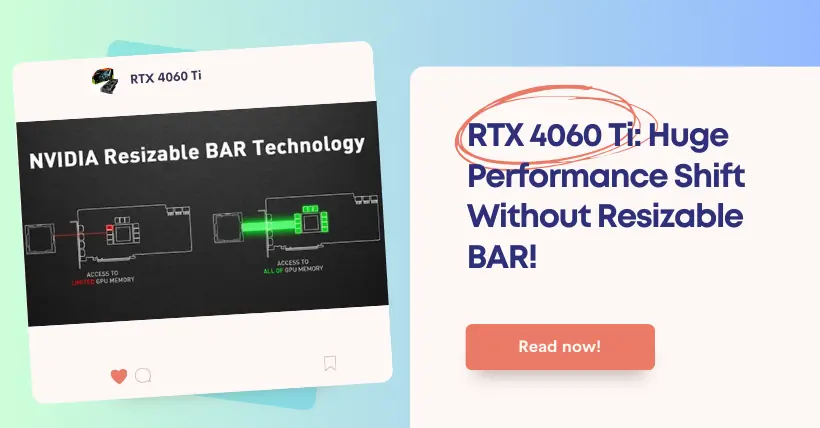
The GeForce RTX 4060 was released on June 29, 2023, using the AD107 GPU based on the Ada Lovelace architecture, with a TSMC 5nm process. It has 3072 CUDA cores, 96 texture units, 32 raster units, 24 multi-unit stream processors, 96 tensor cores, 24 ray tracing units, and an L2 cache of 24MB.
The standard operating frequency is 1830 MHz, with a maximum frequency of 2460 MHz. It is equipped with 8GB of GDDR6 memory, a memory speed of 17 Gbps, a 128-bit memory interface, and a memory bandwidth of 272.0GB/s. The FP32 performance is 15.11 TFLOPS, power consumption is 115W, and the suggested retail price is $299.
02
Test Platform Configuration
The main configuration is as follows:
The processor is a Ryzen 7 5800X3D, the motherboard is an ASUS ROG STRIX B550, the memory is 32GB DDR4 at 3600MHz, the SSD is a Samsung 950 Pro, and the operating system is Windows 10.
03
Gaming Performance Test
Below are tests for five games, all using 1080p high-quality settings. In the series of images below, the left side represents the GeForce GTX 970 platform, and the right side represents the GeForce RTX 4060 platform.
The first game is “Assassin’s Creed: Odyssey.”
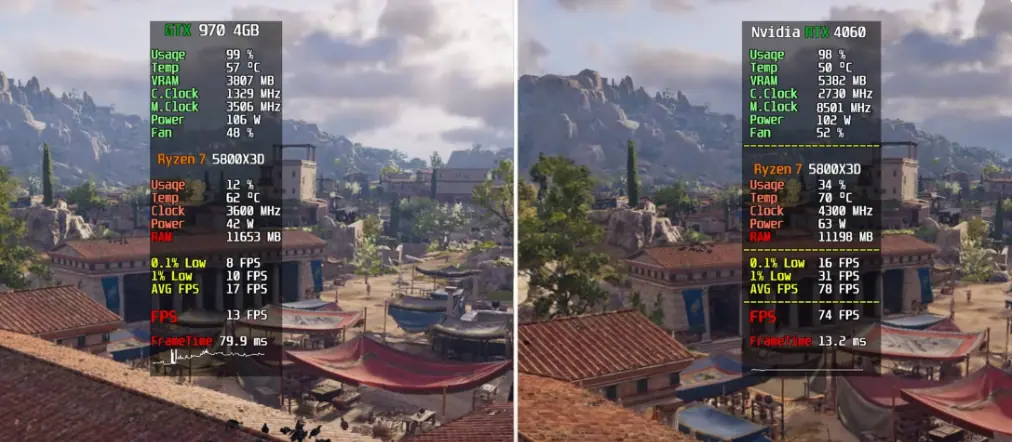
GeForce GTX 970 platform
- Average Frame Rate: 17 FPS
- Lowest Momentary Frame Rate: 10 FPS
- Frame Time: 79.9ms
- CPU usage: 12%
- Power Consumption: 42W
- CPU temperature: 62 degrees
- Memory usage: 11.7GB
- GPU usage: 99%
- VRAM usage: 3.8GB
- Power Consumption: 106W
- GPU temperature: 57 degrees
GeForce RTX 4060 platform
- Average Frame Rate: 78 FPS
- Lowest Momentary Frame Rate: 31 FPS
- Frame Time: 13.2ms
- CPU usage: 34%
- Power Consumption: 63W
- CPU temperature: 70 degrees
- Memory usage: 11.2GB
- GPU usage: 98%
- VRAM usage: 5.4GB
- Power Consumption: 102W
- GPU temperature: 50 degrees
In this game, the GeForce RTX 4060 platform has a 22% higher CPU usage, nearly triple that of the competitor, 0.5GB less memory usage, comparable GPU usage, 1.6GB higher VRAM usage, and the GeForce GTX 970 platform’s VRAM is nearly maxed out.
In terms of average frame rate, the GeForce GTX 970 platform is far from the minimum smooth performance threshold, with the GeForce RTX 4060 platform having 61 FPS more, a staggering 4.6 times higher, the lowest momentary frame rate about 3.1 times higher, and about 67ms lower frame time.
In terms of power consumption and temperature, the GeForce RTX 4060 consumes 4W less power, nearly the same, and is 7 degrees cooler.
The second game is “Borderlands 3.”
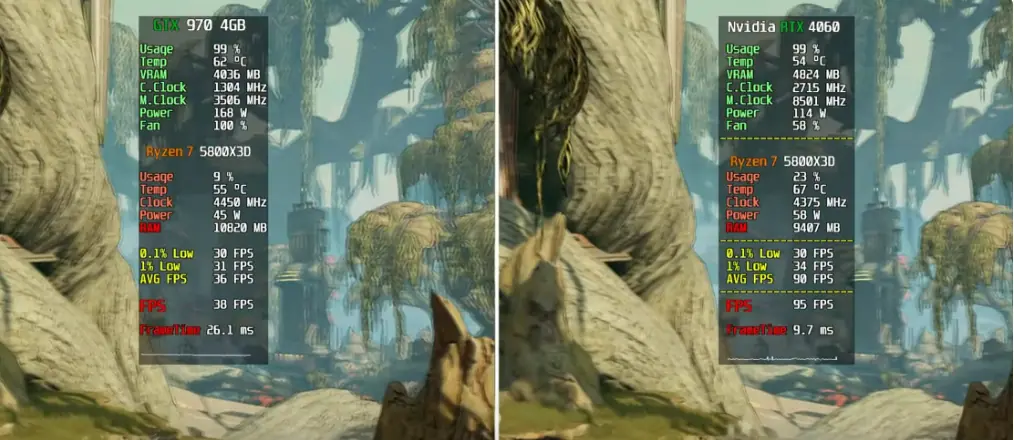
GeForce GTX 970 platform
- Average Frame Rate: 36 FPS
- Lowest Momentary Frame Rate: 31 FPS
- Frame Time: 26.1ms
- CPU usage: 9%
- Power Consumption: 45W
- CPU temperature: 55 degrees
- Memory usage: 10.8GB
- GPU usage: 99%
- VRAM usage: 4.0GB
- Power Consumption: 168W
- GPU temperature: 62 degrees
GeForce RTX 4060 platform
- Average Frame Rate: 90 FPS
- Lowest Momentary Frame Rate: 34 FPS
- Frame Time: 9.7ms
- CPU usage: 23%
- Power Consumption: 58W
- CPU temperature: 67 degrees
- Memory usage: 9.4GB
- GPU usage: 99%
- VRAM usage: 4.8GB
- Power Consumption: 114W
- GPU temperature: 54 degrees
In this game, the GeForce RTX 4060 platform has 13% higher CPU usage, more than double that of the competitor, 1.4GB less memory usage, comparable GPU usage, 0.8GB higher VRAM usage, and the GeForce GTX 970 platform’s VRAM is maxed out.
In terms of average frames, the GeForce RTX 4060 platform is 54 FPS higher, about 2.5 times that of the competitor, the lowest momentary frame rate is 3 FPS higher, nearly equal, the frame time is about 37% of the competitor, and power consumption is 54W lower, and temperature is 8 degrees cooler.
The third game is “Cyberpunk 2077.”
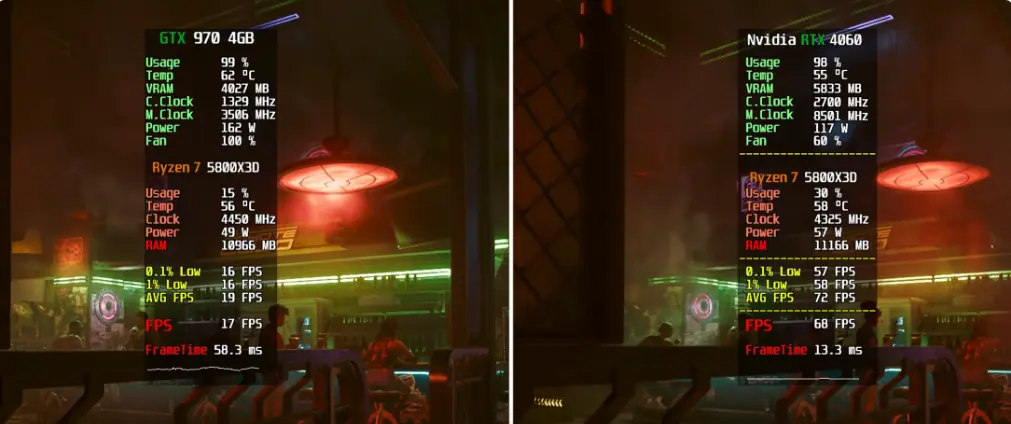
GeForce GTX 970 platform
- Average Frame Rate: 19 FPS
- Lowest Momentary Frame Rate: 16 FPS
- Frame Time: 58.3ms
- CPU usage: 15%
- Power Consumption: 49W
- CPU temperature: 56 degrees
- Memory usage: 11.0GB
- GPU usage: 99%
- VRAM usage: 4.0GB
- Power Consumption: 162W
- GPU temperature: 62 degrees
GeForce RTX 4060 platform
- Average Frame Rate: 72 FPS
- Lowest Momentary Frame Rate: 58 FPS
- Frame Time: 13.3ms
- CPU usage: 30%
- Power Consumption: 57W
- CPU temperature: 58 degrees
- Memory usage: 11.2GB
- GPU usage: 98%
- VRAM usage: 5.8GB
- Power Consumption: 117W
- GPU temperature: 55 degrees
In this game, the GeForce RTX 4060 platform has 15% higher CPU usage, exactly double that of the competitor, 0.2GB less memory usage, comparable GPU usage, 1.8GB higher VRAM usage, and the GeForce GTX 970 platform’s VRAM is also maxed out.
In terms of average frame rate, the GeForce RTX 4060 platform is 53 FPS higher, about 3.8 times that of the competitor, the lowest momentary frame rate is about 3.6 times higher, the frame time is about 23% of the competitor, and power consumption is 45W lower, and temperature is 7 degrees cooler.
The fourth game is “The Witcher 3.”
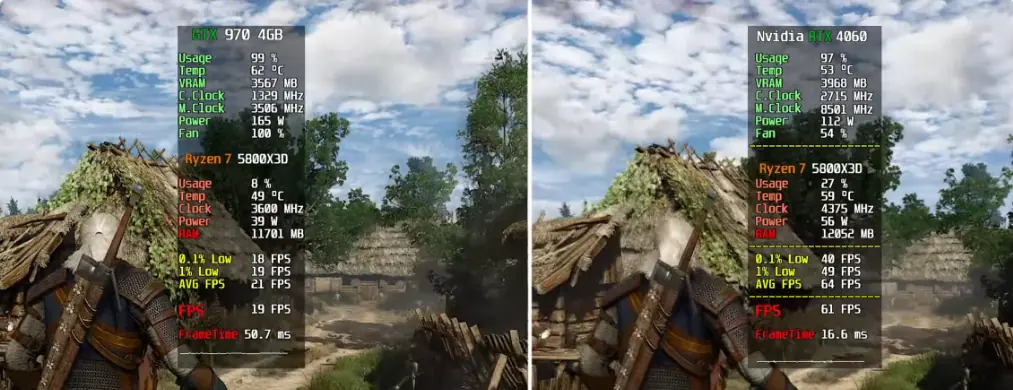
GeForce GTX 970 platform
- Average Frame Rate: 21 FPS
- Lowest Momentary Frame Rate: 19 FPS
- Frame Time: 50.7ms
- CPU usage: 8%
- Power Consumption: 39W
- CPU temperature: 49 degrees
- Memory usage: 11.7GB
- GPU usage: 99%
- VRAM usage: 3.6GB
- Power Consumption: 165W
- GPU temperature: 62 degrees
GeForce RTX 4060 platform
- Average Frame Rate: 64 FPS
- Lowest Momentary Frame Rate: 49 FPS
- Frame Time: 16.6ms
- CPU usage: 27%
- Power Consumption: 56W
- CPU temperature: 59 degrees
- Memory usage: 12.1GB
- GPU usage: 97%
- VRAM usage: 4.0GB
- Power Consumption: 112W
- GPU temperature: 53 degrees
In this game, the GeForce RTX 4060 platform has 19% higher CPU usage, more than three times that of the competitor, 0.4GB higher memory usage, 2% lower GPU usage, and 0.4GB higher VRAM usage.
In terms of average frame rate, the GeForce GTX 970 platform does not meet the minimum smooth performance threshold, the GeForce RTX 4060 platform is 43 FPS higher, about 3.0 times that of the competitor, and the lowest momentary frame rate is about 2.6 times higher, the frame time about 33% of the competitor, power consumption is 53W lower, and temperature is 9 degrees cooler.
The fifth game is “Horizon Zero Dawn.”
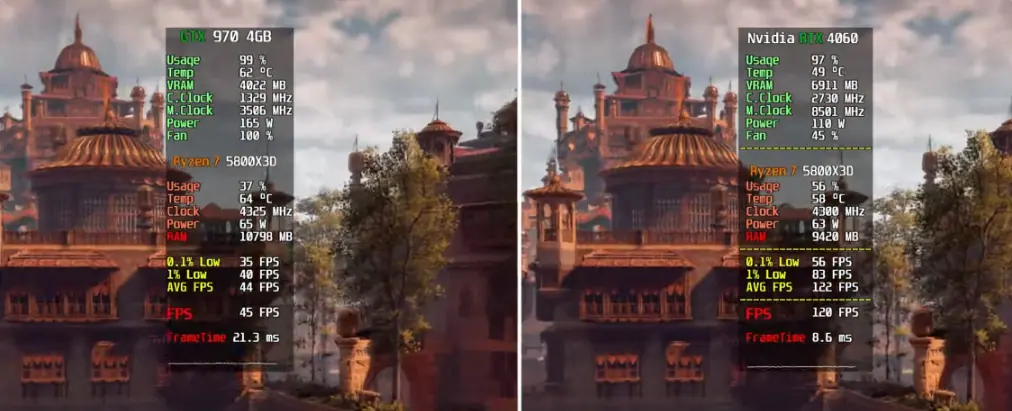
GeForce GTX 970 platform
- Average Frame Rate: 44 FPS
- Lowest Momentary Frame Rate: 40 FPS
- Frame Time: 21.3ms
- CPU usage: 37%
- Power Consumption: 65W
- CPU temperature: 64 degrees
- Memory usage: 10.8GB
- GPU usage: 99%
- VRAM usage: 4.0GB
- Power Consumption: 165W
- GPU temperature: 62 degrees
GeForce RTX 4060 platform
- Average Frame Rate: 122 FPS
- Lowest Momentary Frame Rate: 83 FPS
- Frame Time: 8.6ms
- CPU usage: 56%
- Power Consumption: 63W
- CPU temperature: 58 degrees
- Memory usage: 9.4GB
- GPU usage: 97%
- VRAM usage: 6.9GB
- Power Consumption: 110W
- GPU temperature: 49 degrees
In this game, the GeForce RTX 4060 platform has 19% higher CPU usage, 1.4GB less memory usage, 2% lower GPU usage, 2.9GB higher VRAM usage, and the GeForce GTX 970 platform’s VRAM has reached its limit and is insufficient.
In terms of average frame rate, the GeForce RTX 4060 platform is 78 FPS higher, about 2.8 times that of the competitor, the lowest momentary frame rate is about 2.1 times higher, the frame time is about 40% of the competitor, and power consumption is 55W lower, and temperature is 13 degrees cooler.
04
Comparative Conclusion
Overall, the contest between the GeForce GTX 970 and the GeForce RTX 4060 is decisively one-sided.
In terms of average frame rate, lowest momentary frame rate, frame time, power consumption, and thermal control, the GeForce RTX 4060 is ahead, demonstrating a comprehensive overall advantage.
From the data analyzed, the overall performance of the GeForce RTX 4060 is approximately 3.3 times that of the GeForce GTX 970. This means that upgrading from the GeForce GTX 970 to the GeForce RTX 4060 will yield at least a threefold improvement in performance. This is the conclusion of the article.
Overall, the once-classic GeForce GTX 970 is now severely outdated. Its glory days are over, and it should be completely retired. Relying on it to continue playing mainstream games is now impossible—the era has truly ended, and it’s time to upgrade the graphics card.

Disclaimer: This article is created by the original author. The content of the article represents their personal opinions. Our reposting is for sharing and discussion purposes only and does not imply our endorsement or agreement. If you have any objections, please contact us through the provided channels.








